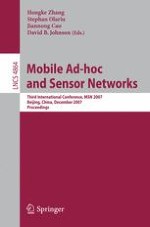2007 | Buch
Mobile Ad-Hoc and Sensor Networks
Third International Conference, MSN 2007 Beijing, China, December 12-14, 2007 Proceedings
herausgegeben von: Hongke Zhang, Stephan Olariu, Jiannong Cao, David B. Johnson
Verlag: Springer Berlin Heidelberg
Buchreihe : Lecture Notes in Computer Science
